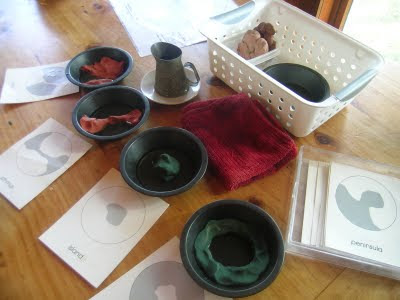Learning Land Forms
While I'm sharing about activities that reside on top of my refridgerator, I thought share about another favorite educational activity: clay land forms. Years ago I made a set with clay and disposable plastic containers. But this fall, I acquired this sweet little set from Michael Olaf Montessori: earth-toned waterproof clay and eight little pie pans are matched with cards so that little students can see that an island is land with water all around it, and a lake is land with water all around it. I keep the materials in a storage bin with a washcloth and tiny water pitcher.
The child can mold islands, pennisulas, and isthmuses of any shape she chooses, and then pour a little bit of water into the wee pie pan to see the relationship between land and water. The earth-toned plasticine clay is superior to salt dough in that it sheds water easily and never dries out. And the matched black pie pans are sturdy beneath the pushing and poking of child fists. After years of making do with my own homemade materials, I'm very pleased with this set, which has a modest price tag for its beauty: $22 for pans and clay. The rather comprehensive card set is only $8 additional: it will last beyond the preschool years well into grade school. It's a wonderful preschool introduction to Classical Conversation's geography program.





Comments